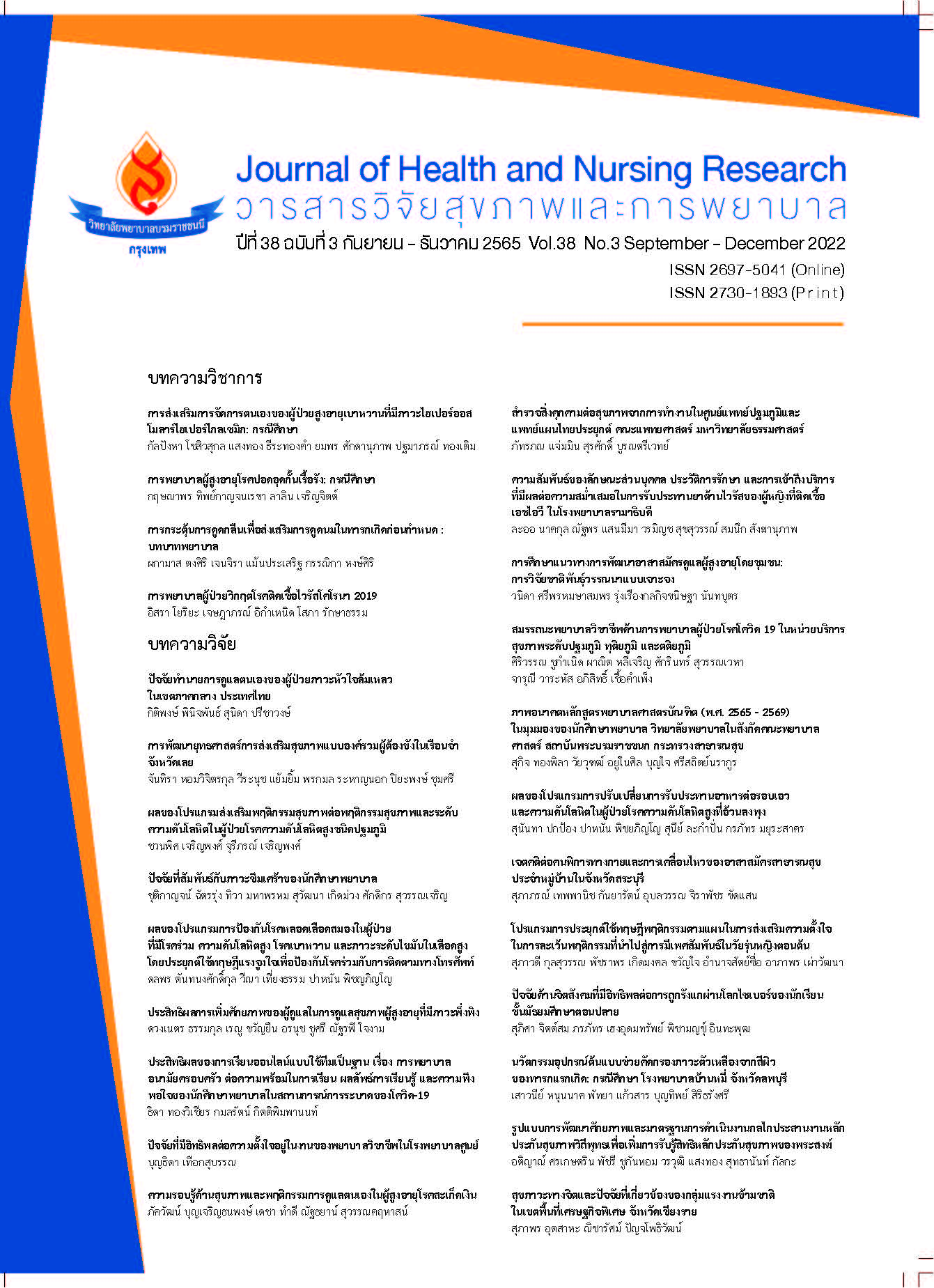ผลของโปรแกรมการป้องกันโรคหลอดเลือดสมองในผู้ป่วยที่มีโรคร่วม ความดันโลหิตสูง โรคเบาหวาน และภาวะระดับไขมันในเลือดสูงโดยประยุกต์ใช้ทฤษฎีแรงจูงใจเพื่อป้องกันโรคร่วมกับการติดตามทางโทรศัพท์
คำสำคัญ:
โปรแกรมการป้องกันโรคหลอดเลือดสมอง , ทฤษฎีแรงจูงใจเพื่อป้องกันโรค , การติดตามทางโทรศัพท์บทคัดย่อ
บทนำ: โรคหลอดเลือดสมอง (Stroke) เป็นปัญหาสาธารณสุขที่สำคัญของประเทศไทย การเจ็บป่วยด้วยโรคร่วมความดันโลหิตสูง โรคเบาหวาน และภาวะระดับไขมันในเลือดสูงส่งผลต่อระบบหลอดเลือดและระบบไหลเวียนโลหิต ทำให้ผู้ป่วยกลุ่มนี้มีความเสี่ยงในการเกิดโรคหลอดเลือดสมองแบบเท่าทวีคูณ
วัตถุประสงค์การวิจัย: เพื่อศึกษาผลของโปรแกรมการป้องกันโรคหลอดเลือดสมองในผู้ป่วยที่มีโรคร่วมความดันโลหิตสูง โรคเบาหวาน และภาวะระดับไขมันในเลือดสูง
ระเบียบวิธีวิจัย: การศึกษาครั้งนี้เป็นการวิจัยแบบกึ่งทดลองแบบสองกลุ่ม โดยแบ่งเป็นกลุ่มที่ได้รับโปรแกรมและกลุ่มเปรียบเทียบกลุ่มละ 32 คน ระยะเวลาศึกษา 8 สัปดาห์ มีการเก็บรวบรวมข้อมูลก่อนการทดลอง หลังการทดลอง (สัปดาห์ที่ 4) และระยะติดตามผล (สัปดาห์ที่ 8) วิเคราะห์ข้อมูลโดยใช้สถิติเชิงพรรณนา, Chi-square, Repeated measure ANOVA, Independent t-test และ Paired t-test
ผลการวิจัย: กลุ่มที่ได้รับโปรแกรมมีคะแนนเฉลี่ยพฤติกรรมการป้องกันโรคหลอดเลือดสมองเพิ่มมากขึ้นกว่าก่อนทดลอง และสูงกว่ากลุ่มควบคุมอย่างมีนัยสำคัญทางสถิติ (p-value< .001) และมีระดับความดันโลหิต ระดับน้ำตาลในเลือด และระดับไขมันในเลือดน้อยกว่าก่อนการทดลองและน้อยกว่ากลุ่มเปรียบเทียบอย่างมีนัยสำคัญทางสถิติ (p-value< .05)
สรุปผล: โปรแกรมสามารถช่วยให้พฤติกรรมการป้องกันโรคหลอดเลือดสมองของกลุ่มตัวอย่างดีขึ้น และสามารถลดระดับความดันโลหิต ระดับน้ำตาลในเลือด และระดับไขมันในเลือดได้
ข้อเสนอแนะ: สามารถนำผลการวิจัยมาใช้เป็นแนวทางในการดูแลผู้ป่วยโรคร่วมความดันโลหิตสูง โรคเบาหวาน และภาวะไขมันในเลือดสูงในการป้องกันการเกิดโรคหลอดเลือดสมองและโรคเรื้อรังอื่น ๆ เช่น โรคหลอดเลือดหัวใจ โรคไตวาย เป็นต้น
Downloads
เอกสารอ้างอิง
World Stroke Organization. World stroke campaign [Internet]. 2019 [cited 2020 November 5]. Available from: https://www.world-stroke.org/world-stroke-day-campaign
Bureau of Policy and Strategy, Ministry of Public Health [Internet]. Public health statistic. 2019 [cited 2020 November 11]. Available from: https://bps.moph.go.th/new_bps/sites/default/files/statistic62.pdf. (in Thai)
Bureau of Policy and Strategy, Ministry of Public Health. Health at a glance Thailand 2017. 1st ed. Bangkok: Srimuang Printing; 2017. (in Thai)
Suwanwela NC. Stroke epidemiology in Thailand. J Stroke 2014; 16(1): 1-7
Prasat Neurological Institute, Ministry of Public Health. Stroke clinical practice guideline for nursing. Bangkok: Thana Place; 2015. (in Thai)
Office of the Permanent Secretary Ministry of Public Health, Ministry of Public Health [Internet]. KPI024.1: Stroke death rate (Stroke: I60-I69). 2020 [cited 2020 November 11]. Available from: http://healthkpi.moph.go.th/kpi2/kpi/index/?id=1428&kpi_year=2563. (in Thai)
Momala K, Kongkam P. Factors affecting to Stroke prevention behaviours of chronic disease patients at Bankao Health Promoting Hospital, Photharam District, Ratchaburi Province. HCU Journal 2020; 24(2): 172-85. (in Thai)
Rogers RW. Cognitive and physiological processes in fear appeals and attitude change: A revised theory of protection motivation. In Cacioppo JT, Pretty RE, editors. Social psychophysiology: A source book. New York: Guilford Press; 1983. p.153-76
Thailand Nursing and Midwifery Council. Guideline for tele-nursing [Internet]. 2021 [cited 2021 March 12]. Available from: https://www.tnmc.or.th/images/userfiles/files/T_0049.PDF. (in Thai)
Avery G, Cook D, Talens S. The impacts of a telephone-based chronic disease management program on medical expenditures. Population Health Management 2016; 19(3): 156-62
Kampan S, Chokchinon A, Junpanit U. Telephone call visit program for out patients receiving service from nurse anesthetist. Thai Journal of Nursing and Midwifery Practice 2015; 2(1):45-54. (in Thai)
Cohen J. Statistical power analysis for the behavioral science. 2nd ed. New Jersey: Lawrence Erlbaum Associates; 1988
Siriket R, Sittipakorn S, Hornboonherm P. Effects of the protection motivation program on protective behavior of the high risk stroke. Srinagarind Med J 2015; 30(3): 299-304. (in Thai)
Khiawkhwao P, Thiangtham W, Boonyamalik R. The effects of the cerebral vascular disease prevention program in high-risk group patients. Journal of Health and Nursing Research 2019; 35(3): 120-32. (in Thai)
Supanikorn C, Thiangtham W, Boonyamalik P. The application of protection motivation theory in promoting the behaviors slowing down the progression of degeneration of CKD stage 3 patients in a community. Nursing Journal of the Ministry of Public Health 2019; 29(2): 165-77. (in Thai)
Tiparat W, Suwanweala S, Sumrit W. The effects of self-awareness development program on stroke prevention behaviors among hypertension patients in Muang District, Trang Province. The Southern College Network Journal of Nursing and Public Health 2017; 4(2): 94-107. (in Thai)
Intaboot K, Kalampakorn S, Pichayapinyo P. The effects of a self-management and social support program for new cases with type 2 diabetes. Journal of Public Health Nursing 2017; 31(2): 11-27. (in Thai)
Somrit T. Effectiveness of behavior changing program to decrease low-density lipoprotein among clients at health checkup clinic in Chiangkham Hospital, Phayao Province. Journal of the Phrae Hospital 2020; 28(2): 80-91. (in Thai)
ดาวน์โหลด
เผยแพร่แล้ว
รูปแบบการอ้างอิง
ฉบับ
ประเภทบทความ
สัญญาอนุญาต
ลิขสิทธิ์ (c) 2022 วารสารวิจัยสุขภาพและการพยาบาล (วารสารวิทยาลัยพยาบาลบรมราชชนนี กรุงเทพ)

อนุญาตภายใต้เงื่อนไข Creative Commons Attribution-NonCommercial 4.0 International License.
บทความที่ได้รับการตีพิมพ์ เป็นลิขสิทธิ์ของวารสารวิจัยสุขภาพและการพยาบาล (วิทยาลัยพยาบาลบรมราชชนนี กรุงเทพ) ไม่สามารถนำไปตีพิมพ์ซ้ำในวารสารฉบับอื่น


















